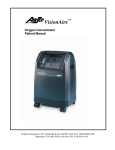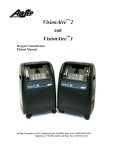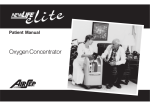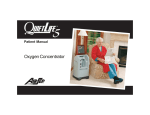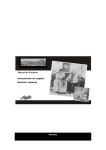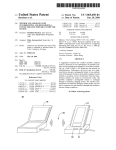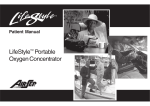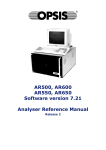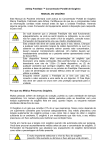Download AirSep VisionAire 3 Product specifications
Transcript
VisionAire™ Oxygen Concentrator Patient Manual AirSep Corporation • 401 Creekside Drive • Buffalo, New York 14228-2085 USA Telephone: (716) 691-0202 • 24-Hour Fax (716) 691-4141 Table of Contents Important Safety Rules Page 1 Section 1 Introduction Page 2 Section 2 Concentrator Components 2.1 Front of Concentrator 2.2 Back of Concentrator 2.3 Humidifier Bottle 2.4 Accessories Page 4 Page 4 Page 6 Page 7 Page 7 Section 3 How to Operate Your Oxygen Concentrator 3.1 Humidifier Bottle Connection 3.2 Cannula Connection 3.3 Starting the Concentrator 3.4 Turning the Concentrator Off Page 8 Page 8 Page 8 Page 8 Page 9 Section 4 Care and Cleaning 4.1 Humidifier Bottle 4.2 Outside Cabinet Page 10 Page 10 Page 10 Section 5 Troubleshooting Page 11 Section 6 Product Specifications Page 13 Section 7 Symbols/Abbreviations Page 15 English: A multilingual version of the manual is available through your equipment provider. Español: Una versión multilingüe del manual está disponible a través de su proveedor de equipo. Français: Une version multilingue du manuel est disponible par l'intermédiaire de votre fournisseur de matériel. Deutsche: Eine mehrsprachige Version des Handbuchs ist in Ihrer Geräte-Anbieter. i Important Safety Rules In the event of an alarm or if you are experiencing any signs of discomfort, consult your Equipment Provider and /or your physician immediately. This unit is not a life-support device. Geriatric, pediatric, or any other patient unable to communicate discomfort while using this oxygen concentrator may require additional monitoring. Patients with hearing and/or sight impairments may need assistance with monitoring the alarms. Consult your physician immediately if you are experiencing any signs of discomfort. This device manufactures high concentration oxygen, which promotes rapid burning. Do not allow smoking or open flames within 5 feet (1.5 meters) of: (1) this device or (2) any oxygen-carrying accessory. Use no oil, grease, or petroleum-based products on or near the unit. Disconnect the power cord from the electrical outlet before cleaning or servicing the unit. Electrical shock hazard. Do not remove covers while the unit is plugged in. Only your Equipment Provider or a qualified service technician should remove the covers or service the unit. Do not leave a nasal cannula under bed coverings or chair cushions. If the unit is turned on but not in use, the oxygen will make the material flammable. Set the I/0 power switch to the 0 (off) position when the VisionAire™ unit is not in use. Do not use extension cords with this unit or connect too many plugs into the same electrical outlet. Use only voltage specified on back panel label. Do not use your oxygen concentrator in the presence of flammable gases. 1 1.0 Introduction This Patient Manual will acquaint you with AirSep’s VisionAire Oxygen Concentrator. Make sure you read and understand all of the information contained in this guide before operating your concentrator. Should you have any questions, your Equipment Provider will be happy to answer them for you. Why Your Physician Prescribed Oxygen Many people today suffer from a variety of heart, lung, and other respiratory diseases. A significant number of these patients can benefit from supplemental oxygen therapy for respiratory care at home, in the hospital, or at a medical facility. Oxygen is a gas that makes up 21% of the room air we breathe. Our bodies depend on a steady supply to function properly. Your physician has prescribed supplemental oxygen therapy because your body is not able to get enough oxygen from room air. Oxygen is a non-addictive drug, and your physician prescribed a flow sufficient to improve your condition. Please keep in mind that unauthorized oxygen therapy can be dangerous. You must seek medical advice before you use this unit. The Equipment Provider who supplies your oxygen equipment will demonstrate how to set the prescribed flow rate. What is an Oxygen Concentrator? Oxygen concentrators were introduced in the mid-1970s and have become the most convenient, reliable source of supplemental oxygen available today. Without an oxygen concentrator, the average patient would require a delivery of 12 bottles/cylinders of oxygen each month. Your oxygen concentrator produces all the oxygen you need, with no deliveries required. The air we breathe contains approximately 21% oxygen, 78% nitrogen, and 1% other gases. In the VisionAire unit, room air passes through a regenerative adsorbent material called molecular sieve. This material separates the oxygen from the nitrogen and other gases. The result is a constant supply of high concentration supplemental oxygen that is delivered to the patient. Note: There is never a danger of depleting the oxygen in a room when you use your VisionAire unit. 2 AirSep recommends an alternate source of supplemental oxygen in the event of a power outage, alarm condition, or mechanical failure. Consult your physician or Equipment Provider for the type of reserve system required. U.S. Federal law restricts this device to sale by or on order of a physician. Use unit in accordance with the manufacturer’s Patient Manual. It is very important to follow the prescribed level of oxygen flow. Do not increase or decrease the flow until you first consult your physician. 3 2.0 Concentrator Components Review the figures below and become familiar with the important parts of your VisionAire Oxygen Concentrator. 2.1 Front of Concentrator Top Handle Hour Meter Oxygen Outlet Side Handle(s) Circuit Breaker Reset Button Flowmeter Adjustment Knob ON/OFF (I/0) Power Switch Operating Instructions Label Low Oxygen Concentration Indicator (optional) Caster(s) Figure 1 ¾ Top and Side Handles: o Enables convenience in carrying the unit. ¾ On/Off (I/0) Power Switch: o Starts and stops the operation of the unit. ¾ Oxygen Outlet o Provides connection for a humidifier (if required) or cannula. ¾ Circuit Breaker Reset Button: o Resets the unit after electrical overload shutdown. ¾ Flowmeter Adjustment Knob: o Controls the oxygen flow rate in liters per minute (LPM). 4 ¾ Low Oxygen Concentration Indicator (optional): o Illuminates (amber) if the unit is equipped with optional Oxygen Monitor and detects low oxygen concentration. ¾ Hour Meter: o Records the concentrator’s hours of operation. ¾ Operating Instructions Label: o Directs usage of the unit. ¾ Casters: o Four casters enable unit to be easily moved, as needed. 5 2.2 Back of Concentrator Humidifier Bottle Recess Specification Label Power Cord Figure 2 ¾ Power Cord: o Allows connection of the unit to an electrical outlet. ¾ Humidifier Bottle Recess: o Area to place the optional humidifier bottle. ¾ Specification Label: o Displays electrical specifications and serial number. 6 2.3 Humidifier Bottle (optional) Humidifier Bottle Fitting Humidifier Bottle Oxygen Outlet Humidifier Bottle Tubing Humidifier Bottle Oxygen Tubing/Cannula Figure 3 ¾ Humidifier Bottle (optional): o Humidifies the oxygen before it reaches the patient. ¾ Humidifier Bottle Oxygen Outlet: o Connection for oxygen tubing/cannula. 2.4 Accessories Accessories recommended for use with the VisionAire Oxygen Concentrator include: ¾ Humidifier Bottle o AirSep part number – HU003-1 ¾ Cannula, 25 feet (7.6 m) o AirSep part number – CU002-4 ¾ Humidifier Bottle Tubing o AirSep part number – TU176-160 ¾ Humidifier Bottle Fitting o AirSep part number – F0655-1 ¾ Oxygen Tubing, 25 feet (7.6 m) o AirSep part number – CU004-3 ¾ Tubing/Cannula Connector o AirSep part number – CU009-1 7 3.0 How To Operate Your Oxygen Concentrator Review the following information before you operate your oxygen concentrator. 3.1 Humidifier Bottle (Optional) If additional humidification is required with your oxygen therapy, perform the following steps each time you fill or clean the humidifier, which may have been initially set up for your use. 1. Remove the humidifier bottle from the humidifier bottle recess. 2. Open the humidifier bottle. If you have a pre-filled bottle, do not perform this step. Proceed to step 5. 3. Fill the humidifier bottle with cool or cold water (distilled water is preferred) to the fill line indicated on the bottle. DO NOT OVERFILL. 4. Re-connect the top cover to the humidifier bottle. 5. Place the humidifier bottle in the humidifier bottle recess on the back of the concentrator and connect the humidifier bottle tubing to the oxygen outlet and the humidifier bottle fitting. If the humidifier bottle tubing is not properly connected to the humidifier bottle fitting or to the oxygen outlet, an oxygen leak can occur. 3.2 Cannula Connection Connect the tubing and cannula to the unit’s oxygen outlet, or to the optional humidifier’s oxygen outlet. 3.3 Starting the Concentrator Do not use extension cords with this unit. Position the unit away from curtains or drapes, hot air registers or heaters. Be certain to place the unit on a flat surface and make sure all sides are at least 1 foot (30 cm) away from a wall or other obstruction. Do not place the unit in a confined area. Choose a dust and smoke free-location away from direct sunlight. 8 1. Locate the unit near the electrical outlet in the room where you spend most of your time. 2. Insert the power cord plug into the electrical outlet. 3. Set the I/0 power switch to the “I” position to turn the unit on. An audible alarm will loudly sound for approximately 5 seconds. 4. The low oxygen concentration indicator remains on for a few minutes and until the oxygen concentration reaches minimum concentration requirements, (only pertains to unit equipped with an Oxygen Monitor) 5. To set the flow of supplemental oxygen, turn the flowmeter adjustment knob left or right until the ball inside the flowmeter centers on the flow line number prescribed by your physician. To view the flowmeter at the proper angle, note that the back line and the front number line must give appearance of one line. 6. The concentrator is now ready for use. It is very important to follow the prescribed level of oxygen flow. Do not increase or decrease the flow until you first consult your physician. Normally, you should not need to adjust the flowmeter on your unit. If you turn the flowmeter adjustment knob clockwise, you will decrease and can shut off the flow of oxygen from your unit. If oxygen does not seem to flow, first verify that the flowmeter ball is registering a flow. Then, place the tip of the cannula into a glass of water; if bubbles come out of the cannula, oxygen is flowing. If bubbles do not appear, refer to Section 5.0. Troubleshooting. Ensure concentrator is operated in an upright position. 3.4 Turning the Concentrator Off • Set the I/0 power switch to the “0” position to turn off the unit. 9 4.0 Care and Cleaning Disconnect the power cord from the electrical outlet before you clean the cabinet or control panel. Do not use liquid directly on the unit. Do not use any petroleum-based solvents or cleaning agents. Clean the cabinet, control panel, and power cord only with a mild household cleaner applied with a damp cloth or sponge, and then wipe all surfaces dry. 4.1 Humidifier Bottle (optional) • • 4.2 Check water level daily and add water as needed To clean and disinfect the humidifier, follow your Equipment Provider’s instructions, or the instructions included with the humidifier bottle. Outside Cabinet Use a mild household cleaner applied with a damp cloth or sponge to clean the exterior of the concentrator, and then wipe all surfaces dry. 10 5.0 Troubleshooting If your concentrator fails to operate properly, consult your Equipment Provider, and refer to the troubleshooting chart on the following pages for probable causes and solutions. Do not attempt any maintenance other than the possible solutions listed below. If the unit has not been used for an extended time period, it needs to operate for several minutes before power failure alarm can become activated. Problem Unit does not operate. Power failure condition causes an alarm to sound. Probable Cause The power cord is not connected to the electrical outlet. Solution Check power cord at the electrical outlet for a proper connection. No power at the electrical outlet. Check power source, wall switch, in-house fuse or circuit breaker. Circuit breaker on concentrator unit is activated. Press (do not hold in) the circuit breaker reset button in the front of the unit. If the circuit breaker trips again or the alarm continues to sound after the unit is turned on, contact your Equipment Provider. Limited or no oxygen flow. Dirty or obstructed Remove the humidifier humidifier bottle, or leak bottle, and if flow is present. restored, clean or replace the humidifier bottle. Defective nasal cannula, or other oxygen accessories, i.e. oxygen tubing. Remove and check accessories for kinks or obstructions. Replace if needed. Cannula tubing loose. Check cannula tubing connection at control panel. 11 Problem Probable Cause Condensation collects in the oxygen tubing when you use a humidifier bottle Unit not properly ventilated. Elevated operating temperatures. Intermittent alarm sounds at one second intervals. Equipment malfunction. All other problems. 12 Solution Make sure unit is positioned away from curtains or drapes, hot air registers or heaters, Be certain to place the unit so all sides are at least 1 foot (30 cm) away from a wall or other obstruction. Do not place the unit in a confined area. Refill humidifier bottle with COLD water. DO NOT OVERFILL. Allow oxygen tubing to dry out, or replace with new tubing. Set I/0 power switch to 0 position, use your reserve oxygen supply (if provided), and consult your Equipment Provider immediately. Set I/0 power switch to the 0 position, use your reserve oxygen supply (if provided), and consult your Equipment Provider immediately. 6.0 Product Specifications VisionAire Oxygen Concentrator Oxygen Concentration Electrical Requirements Flow Rate O2 Concentration 1 – 5 lpm 90% + 5.5% / - 3% Based on an atmospheric pressure of 14.7 psia (101 kPa) at 70°F (21°C) 115 VAC / 60 Hz 220 -240 VAC / 50 Hz 220 VAC / 60 Hz Power Consumption Dimensions 290Watts 14.1 in. W x 11.5 in. D x 20.8 in. H (35.8 cm W x 29.2 cm D x 52.8 cm H) Weight Alarms 30 lbs (13.6 kg) Power Failure Low Pressure High Pressure High Temperature Low Oxygen Concentration (with optional Oxygen Monitor) Electrical Shock Protection Class II, Type B Operating Temperature Range 41 to 105 oF (5 to 40 oC) Storage Temperature Range -4 to 140 oF (-20 to 60 oC) 13 Conformity with EN 60-601 (§ § 6.8.2 b): “The manufacturer, assembler, installer or importer are not considered to be responsible themselves for the consequences on the safety, reliability and characteristics of a device unless: - The assembly, fitting, extensions, adjustments, modifications or repairs have been performed by persons authorized by the party in question, - The electrical installation of the corresponding premises complies with IEC regulations. - The device is used in accordance with the instructions for use. “If the replacement parts used for the periodic servicing by an approved technician do not comply with the manufacturer’s specifications, the latter is absolved from all responsibility in the event of an accident. Do not open the device while in operation: risk of electrical shock. This device complies with the requirements of the 93/42/EEC European directive but its operation may be affected by other devices being used close by, such as diathermy and high frequency electro-surgical equipment, defibrillators, short wave therapy equipment, mobile telephones, CB and other portable devices, microwave ovens, induction plates or even remote control toys and more generally electromagnetic interferences which exceed the levels specified by the ECN 60601-1-2 standard. Classification Type of protection against electric shock: Class II Protection from electric shock is achieved by DOUBLE INSULATION. Protective earthing or reliance upon installation conditions are not required. Degree of protection against electric shock: Type B Equipment providing a particular degree of protection against electric shock, particularly regarding: 1) Allowable leakage current; 2) Reliability of protective earth connection (if present). Not intended for direct cardiac application. Method of cleaning and infection control allowed: Please refer to your Equipment Provider and the VisionAire Service Manual. Degree of safety of application in the presence of flammable gases: Equipment not suitable for such application. Mode of operation: Continuous duty. 14 7.0 Symbols/Abbreviations Symbols are frequently used on equipment in preference to words with the intention of lessening any possibility of misunderstanding caused by language differences. Symbols can also permit easier comprehension of a concept within a restricted space. The following table is a list of symbols and definitions that may be used with AirSep’s VisionAire Oxygen Concentrator. These symbols are referenced from the appropriate International Electro-technical Commission (IEC) standards: Method of disposing of waste: All waste from AirSep’s VisionAire Oxygen Concentrator must be disposed of using the appropriate methods. Method for disposing of the device: In order to preserve the environment, the concentrator must be disposed of using the appropriate methods. Cet appareil produit de l’oxygène à concentration élevée, favorisant une combustion rapide. Ne pas permettre de fumer ou des flammes nues dans un rayon de 5 pieds (1,5 mètre) de : (1) cet appareil ou (2) tout accessoire contenant de l’oxygène. Ne pas utiliser de produits à base d’huile, de graisse ou de pétrole sur ou à proximité de l’unité. Déconnecter le cordon d’alimentation de la prise électrique avant de nettoyer ou de faire l’entretien de l’unité. Risque de choc électrique. Ne pas enlever les couvercles lorsque l’unité est branchée. Seuls votre fournisseur d’équipement ou un technicien de service qualifié devrait enlever les couvercles ou faire l’entretien de l’unité. 15 |MN136-1_BK~ MN136-1 Rev B 12/08





















